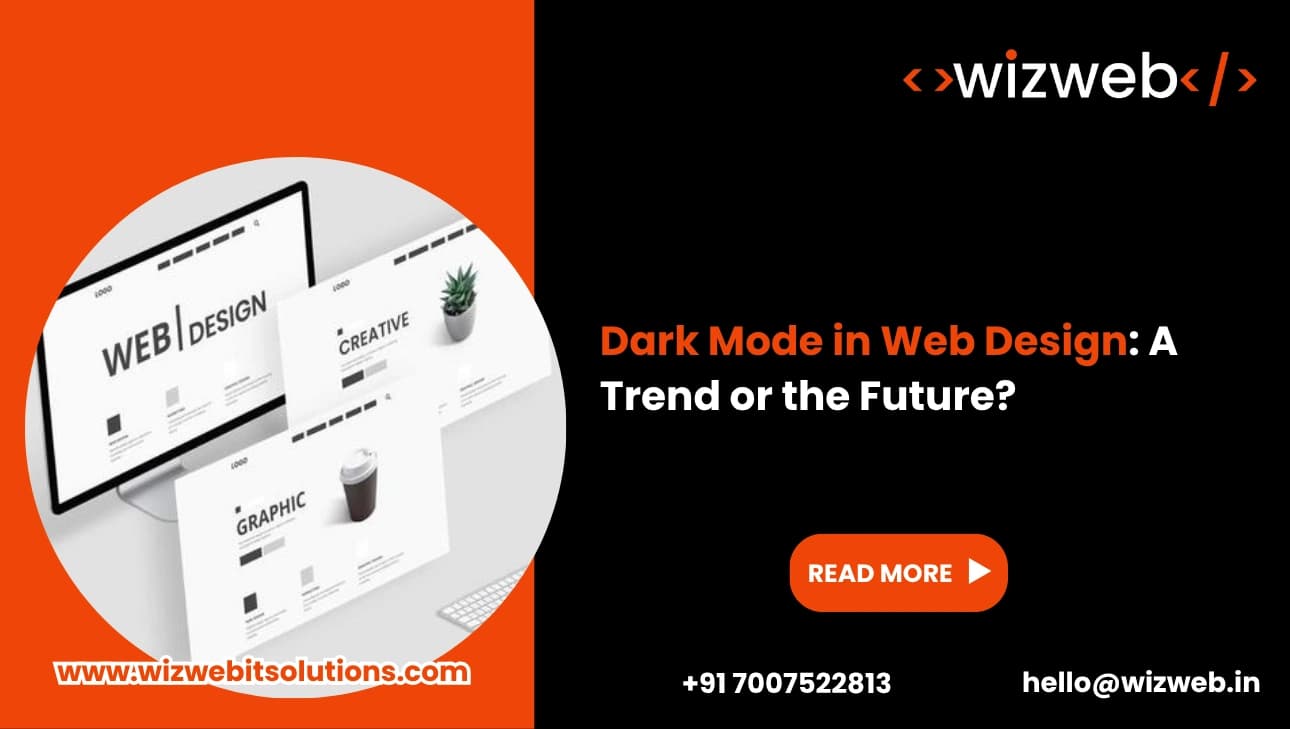Get in Touch
- Phone
+91 700 752 2813
- Email Now
hello@wizweb.in
Office No - 204 A-140, Sector 63 Road Noida, Uttar Pradesh 201301

In recent years, dark mode has become a favorite feature for many people using websites, apps, and even mobile phones. You may have noticed your favorite app asking, “Do you want to switch to dark mode?” More and more websites are now offering this feature. But the real question is—is Dark Mode in Web Design just a trend, or is it the future of how we experience the internet?
Let’s explore this in detail in simple and clear language, so by the end of this blog, you’ll have a full understanding of what dark mode is, why it matters, and whether your website needs it too.
Dark Mode in Web Design means using light-colored text, icons, and design elements on a dark background. Normally, websites use dark text on a white or light background. But dark mode flips that around. It replaces bright screens with dark colors like black or deep grey while keeping the content clear and easy to read.
You can see dark mode in action on apps like YouTube, Twitter, Instagram, and Facebook. Even popular operating systems like Android, iOS, and Windows have built-in dark mode options now. This shows that dark mode is not just a temporary feature—it’s becoming a standard in the digital world.
There are many reasons why Dark Mode in Web Design is growing in popularity. Let’s take a closer look:
One of the biggest reasons people love dark mode is that it’s easier on the eyes, especially in low light or at night. Bright white backgrounds can cause eye strain after long hours of screen time. Dark mode reduces glare and makes it more comfortable to read.
If you are using a phone with an OLED or AMOLED screen, using dark mode can save battery. This is because black pixels use less power on such screens, helping your device last longer between charges.
Dark Mode in Web Design gives websites a modern, classy look. It makes colors, buttons, and images stand out more. For businesses trying to build a stylish online presence, dark mode helps create a strong first impression.
Dark backgrounds help important elements pop. Your eyes naturally focus on the bright content, like text or call-to-action buttons. This improves readability and keeps users engaged.
People are now expecting dark mode. Studies show that more than 80% of smartphone users prefer dark mode, especially at night. So, if your website offers it, users may stay longer and return more often.
Like any design style, Dark Mode in Web Design has both advantages and disadvantages.
If you’re planning to add Dark Mode in Web Design for your website, or if you’re offering professional Web Design Services, here are some best practices to follow:
Pure black can be too harsh. Instead, use dark gray for a softer, more comfortable look. This also helps reduce eye fatigue.
Just like black can be too strong, pure white on a dark background can also be hard to read. Use off-white or light gray for better readability.
Make sure your colors, fonts, and layout still reflect your brand’s personality. Don’t just switch to dark mode without adjusting your design elements properly.
Let users switch between dark and light modes. A simple toggle button gives users control over their experience and increases satisfaction.
Test your design to ensure it’s readable for all users, including those with visual challenges. Make sure there is enough contrast between background and text.
Here are some well-known websites and apps that use Dark Mode in Web Design effectively:
These examples show that dark mode works across different platforms, from entertainment to communication to professional tools.
So, is Dark Mode in Web Design just a passing trend?
The answer is no. Dark mode is slowly becoming a standard feature. More websites and apps are offering it, and users are now expecting it. It’s not just about looks—it’s about comfort, style, and giving users what they want.
With mobile use rising and people spending more time online, the need for eye-friendly design is increasing. Dark mode fits perfectly into this future. In fact, companies that offer Web Design Services are now including dark mode as part of their design packages.
Also, as we move toward more personalized online experiences, giving users the choice between light and dark themes will likely become the norm.
Dark Mode in Web Design is not just a trend—it’s a smart, user-friendly option that adds value to modern websites. It helps reduce eye strain, saves battery, makes your content look stylish, and keeps users engaged longer.
If you’re thinking about redesigning your website, or starting a new one, you should definitely consider adding dark mode. And if you’re looking for expert Web Design Services, make sure to work with a team that understands how to design both light and dark modes effectively.
By adding this small but powerful feature, you’re not just following a trend—you’re building a better experience for your visitors. And that’s what good web design is all about.